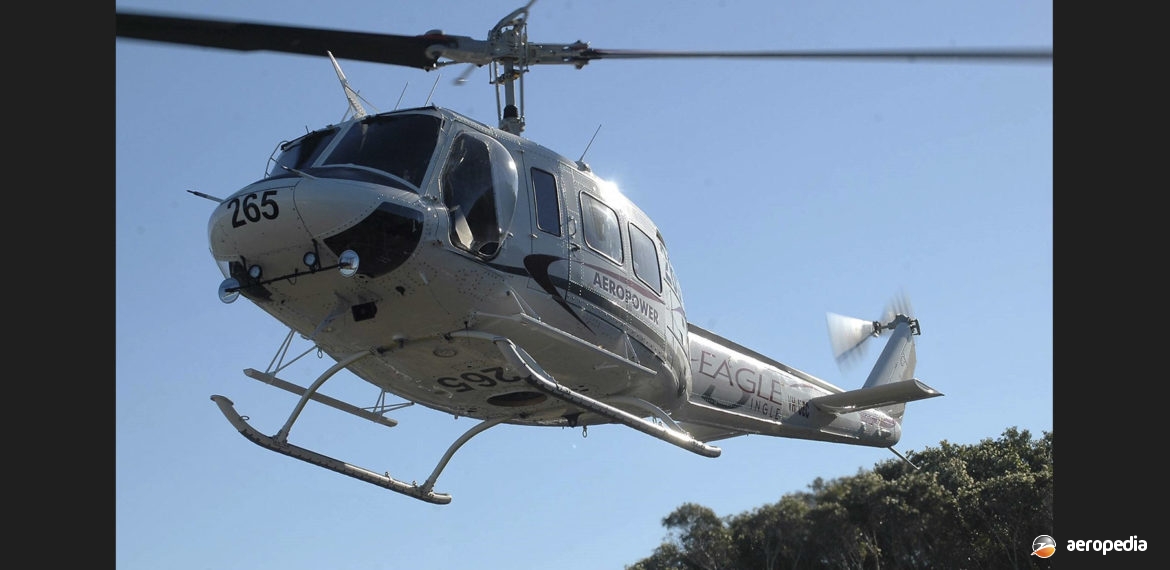Photograph:
Bell 212 Eagle Single VH-UEC (c/n 30640) at Redcliffe, QLD in 2014 (P J Ricketts)
Country of origin:
United States of America
Description:
Utility helicopter
Power Plant:
One 1,343 kw (1,800 shp) Honeywell T53-17 or T53-BCV turboshaft
Specifications:
- Fuselage length: 12.92 m (42 ft 4 in)
- Overall length with rotor and tail rotor turning: 17.46 m (57 ft 3 in)
- Fuselage width: 2.43 m (8 ft)
- Height: 3.9 m (12 ft 8 in)
- Never exceed speed: 241 km/h (150 mph)
- Economical cruising speed: 204 km/h (127 mph)
- Service ceiling: 6,096 m (20,000 ft)
- Hovering ceiling at max gross weight at sea level: 2,377 m (7,800 ft)
- Rate of climb at 120 km/h (75 mph): 433 m/min (1,420 ft/min)
- Fuel capacity standard tank: 834 litres (179 Imp gals)
- Fuel capacity of auxiliary or ferry tank: 681 litres (150 Imp gals)
- Max range with standard fuel: 622 km (387 miles)
- Range with auxiliary fuel no reserves: 1,156 km (718 miles)
- Endurance: 3.07 hrs
- Empty weight: 2,722 kg (6,000 lb)
- Useful load: 2,363 kg (5,210 lb)
- Cargo hook capacity: 2,041 kg (4,500 lb)
- Loaded weight: 5,080 kg (11,200 lb)
History:
Eagle Copters of Calgary, Alberta, Canada, received STC approval for the conversion of Bell 212s to single-engine configuration and delivered the first conversion to Great Slave Helicopters of Yellowknife in the Northwest Territories, Canada. The single powerplant modification reduced the helicopter’s empty weight by 305 kg (1,000 lb) to 2,540 kg (5,600 lb) and increased the internal useful load from 2,087 kg (4,600 lb) to 2,495 kg (5,500 lb). Typical cost of a conversion, with Eagle supplying the airframe, was $3.5 million to $3.7 million, the Company President Michael O’Reilly stating the Company planned to deliver four more Eagle Singles during 2012.
The Company initially delivered three single-engine Bell 212 conversions, the Eagle Single featuring a single Honeywell T53-17A, T53-17B or T53-BCV turboshaft engine in place of the Pratt & Whitney Canada PT6T-3B Twin-Pac of the Model 212.
Subsequently Eagle Copters Australasia marketed the Bell 212 Eagle Single as a new entrant into the Bell Medium Lift helicopter market offering ‘unmatched performance with increased reliability’. Based at Coffs Harbour Airport, NSW and led by Managing Director, Grant Boyter, and Chief Engineer, Rohan Schallmeiner, Eagle Copters Australasia offered helicopter leasing, sales and support services.
The Eagle Single was an STC conversion of the Bell 212 helicopter from a twin engine to a single engine application. While maintaining the Type Certificate of the Bell 212, owners and operators alike received the benefit of the Bell 212, such as the 5,080 kg (11,200 lb) gross weight limitation, common Model 212 part numbers, dual hydraulics, enhanced Model 212 airframe structure and the availability of spare parts. As a by-product of the conversion the Eagle Single had a resulting loss of weight from removing one engine, the reduction gearbox, the original avionics, instruments and associated wiring producing a medium helicopter below the 2,722 kg (6,000 lb) empty weight. Reliability was enhanced by the introduction of modern avionics, instrument and fuel panel upgrades that permitted a reduced cost of operation, allowing for greater operational profits. The Eagle Single was certified in Canada, the USA, Australia, Chile, Peru and Indonesia.
An Eagle Single was leased and placed in service in Irian Jaya operating up to 4,300 m (14,107 ft) for three years with good results. It has also been operated in North America and found to be ideal for fire-fighting duties.
At least one example of the Bell 212 has been imported to Australia and has operated from Redcliffe in Queensland. This aircraft VH-UEC (c/n 30640 – ex C-GAZF, 9Y-TEY, HK4518X, 9Y-TEY, VR-BFE, N18091) was built in 1974 and in later years had the two turboshafts removed and replaced with a single 1,343 kw (1,800 hp) Honeywell T-53 as part of an up-grade.
One Australian registered Eagle Single was modified to spray Thermo-Gel fire retardant with an accuracy of up to 70 m (230 ft), the machine operating in January 2000 during the Australian east-coast fire season in the Batemans Bay and Moruya, NSW areas. It was tasked for fire- fighting operations for 40 or more days and flew more than 300 hours from November 2019. It was also involved in water bombing at the Gospers Mountain fire in the Hawkesbury area, in the Turramurra area in Sydney, NSW and in the Cessnock, NSW fires.
The retardant operator was seated in the rear of the helicopter and used nozzles similar to those used by fire-fighters on the ground, spraying from a 1,400 litre (308 Imp gal) belly tank of water and a 400 litre (88 Imp gal) tank for the Thermo-Gel, the operation being powered by a diesel-powered pump. The material used was Thermo-Gel 300, which was fully bio-degradable and had been approved for use in Australia, the United States and Canada.

